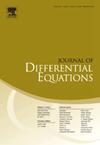关于poincar_3 - dulac范式的计算
IF 2.3
2区 数学
Q1 MATHEMATICS
引用次数: 0
摘要
有两种方法可以计算ode系统的poincar本文章由计算机程序翻译,如有差异,请以英文原文为准。
On computations of Poincaré-Dulac normal forms
There are two approaches to computing Poincaré-Dulac normal forms of systems of ODEs. Under the original approach used by Poincaré and Dulac the normalizing transformation is explicitly computed. On each step, the normalizing procedure requires the substitution of a polynomial into a series. Under the other approach, a normal form is computed using Lie transformations. In this case, the changes of coordinates are performed as actions of certain infinitesimal generators. In both cases, on each step the homological equation is solved in the vector space of polynomial vector fields where each component of the vector field is a homogeneous polynomial of degree j. We present a novel approach which leads to two new algorithms for normal form computations. The first one is designed for polynomial systems of ODEs in which the coefficients of all terms are treated as parameters. While our method employs Lie transformations, the homological equation is solved not in but in the vector space of polynomial vector fields where each component is a homogeneous polynomial in the parameters of the system. It is shown that the space of the parameters is a kind of dual space and the computation of normal forms can be performed in the space of parameters treated as the space of generalized vector fields, which we call the lattice vector fields. The second algorithm applies to any analytic or formal autonomous system of ODEs and offers one of the simplest normal form computation methods available in the literature. Remarkably, the procedure involves only arithmetic operations with scalars, significantly simplifying the computational process.
求助全文
通过发布文献求助,成功后即可免费获取论文全文。
去求助
来源期刊
CiteScore
4.40
自引率
8.30%
发文量
543
审稿时长
9 months
期刊介绍:
The Journal of Differential Equations is concerned with the theory and the application of differential equations. The articles published are addressed not only to mathematicians but also to those engineers, physicists, and other scientists for whom differential equations are valuable research tools.
Research Areas Include:
• Mathematical control theory
• Ordinary differential equations
• Partial differential equations
• Stochastic differential equations
• Topological dynamics
• Related topics

 求助内容:
求助内容: 应助结果提醒方式:
应助结果提醒方式:


